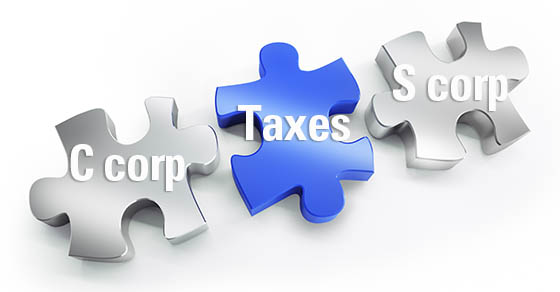When deciding on the best structure for your business, one option to consider is a C corporation. This entity offers several advantages and disadvantages that may significantly affect your business operations and financial health. Here’s a detailed look at the pros and cons of operating as a C corporation.
Tax implications
A C corporation allows the business to be treated and taxed separately from you as the principal owner. The corporate tax rate is currently 21%, which is lower than the highest noncorporate tax rate of 37%.
One of the primary disadvantages of a C corporation is double taxation. The corporation’s profits are taxed at the corporate level and then any dividends distributed to shareholders are taxed again at the individual level. This can result in a higher overall tax burden than other business structures. However, since most of the corporate earnings will be attributable to your efforts as an employee, the risk of double taxation is minimal since the corporation can deduct all reasonable salary that it pays to you.
Because the corporation is taxed as a separate entity, all items of income, credit, loss and deduction are computed at the entity level when arriving at corporate taxable income or loss. One potential disadvantage to a C corporation for a new business is that losses are trapped at the entity level and, thus, generally can’t be deducted by the owners. However, if you expect to generate profits in year one, this might not be a problem.
Liability protection
One of the most significant advantages of a C corporation is the limited liability protection it offers. Shareholders aren’t personally liable for the corporation’s debts and liabilities. This means personal assets are generally protected if the business faces legal issues or bankruptcy.
Complying with requirements
To ensure that a corporation is treated as a separate entity, it’s important to observe various formalities required by your state. These include:
- Filing articles of incorporation,
- Adopting bylaws,
- Electing a board of directors,
- Holding organizational meetings, and
- Keeping minutes of meetings.
Complying with these requirements and maintaining an adequate capital structure will ensure you don’t inadvertently risk personal liability for the business’s debts.
Fringe benefits
A C corporation can also be used to provide fringe benefits and fund qualified pension plans on a tax-favored basis. Subject to certain limits, the corporation can deduct the cost of a variety of benefits such as health insurance and group life insurance without adverse tax consequences to you. Similarly, contributions to qualified pension plans are usually deductible but aren’t currently taxable to you.
Raising capital
A C corporation also gives you considerable flexibility in raising capital from outside investors. A C corporation can have multiple classes of stock — each with different rights and preferences that can be tailored to fit your needs and those of potential investors. Also, if you decide to raise capital through debt, interest paid by the corporation is deductible.
The right fit
Although the C corporation form of business could be appropriate for you at this time, you may be able to change the corporation from a C corporation to an S corporation in the future, if S status is more appropriate at that time. This change will ordinarily be tax-free, except that built-in gain on the corporate assets may be subject to tax if the assets are disposed of by the corporation within 10 years of the change.
This is only a brief overview of the pros and cons of being a C corporation. Contact us if you have questions or would like to explore the best choice of entity for your business.







